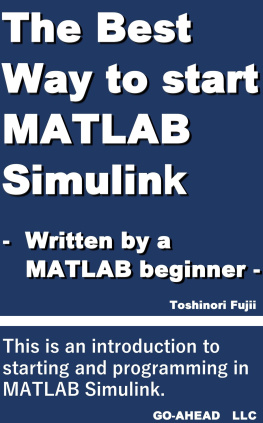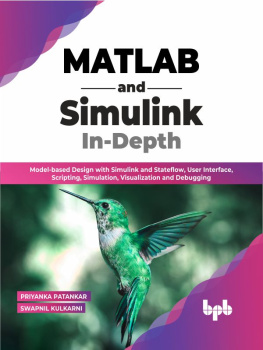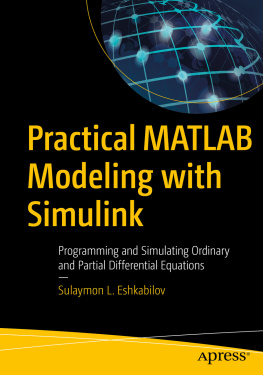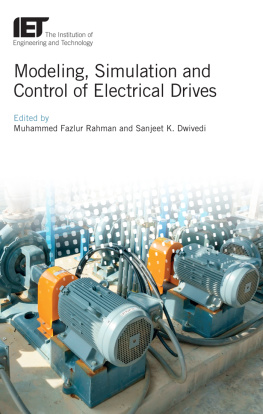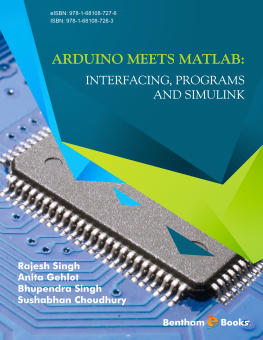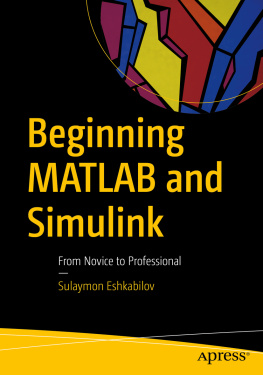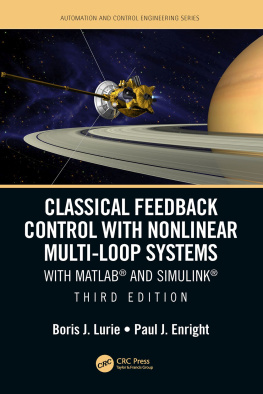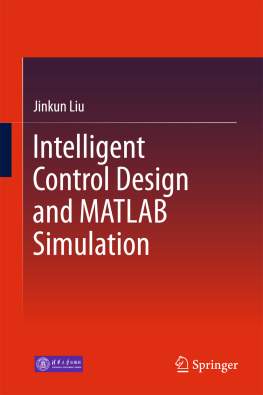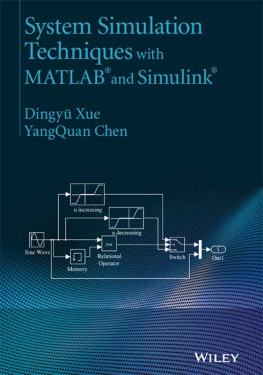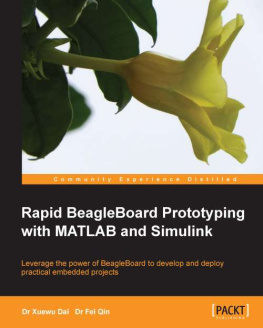Wang Liuping - PID Control System Design and Automatic Tuning Using MATLAB/Simulink
Here you can read online Wang Liuping - PID Control System Design and Automatic Tuning Using MATLAB/Simulink full text of the book (entire story) in english for free. Download pdf and epub, get meaning, cover and reviews about this ebook. year: 2020, publisher: Wiley, genre: Computer. Description of the work, (preface) as well as reviews are available. Best literature library LitArk.com created for fans of good reading and offers a wide selection of genres:
Romance novel
Science fiction
Adventure
Detective
Science
History
Home and family
Prose
Art
Politics
Computer
Non-fiction
Religion
Business
Children
Humor
Choose a favorite category and find really read worthwhile books. Enjoy immersion in the world of imagination, feel the emotions of the characters or learn something new for yourself, make an fascinating discovery.

- Book:PID Control System Design and Automatic Tuning Using MATLAB/Simulink
- Author:
- Publisher:Wiley
- Genre:
- Year:2020
- Rating:3 / 5
- Favourites:Add to favourites
- Your mark:
- 60
- 1
- 2
- 3
- 4
- 5
PID Control System Design and Automatic Tuning Using MATLAB/Simulink: summary, description and annotation
We offer to read an annotation, description, summary or preface (depends on what the author of the book "PID Control System Design and Automatic Tuning Using MATLAB/Simulink" wrote himself). If you haven't found the necessary information about the book — write in the comments, we will try to find it.
Wang Liuping: author's other books
Who wrote PID Control System Design and Automatic Tuning Using MATLAB/Simulink? Find out the surname, the name of the author of the book and a list of all author's works by series.
PID Control System Design and Automatic Tuning Using MATLAB/Simulink — read online for free the complete book (whole text) full work
Below is the text of the book, divided by pages. System saving the place of the last page read, allows you to conveniently read the book "PID Control System Design and Automatic Tuning Using MATLAB/Simulink" online for free, without having to search again every time where you left off. Put a bookmark, and you can go to the page where you finished reading at any time.
Font size:
Interval:
Bookmark:
- Chapter 1
- Chapter 2
- Chapter 8
- Chapter 9
- Chapter 10
- Chapter 1
- Chapter 2
- Chapter 3
- Chapter 4
- Chapter 5
- Chapter 6
- Chapter 7
- Chapter 8
- Chapter 9
- Chapter 10

Liuping Wang
RMIT University
Australia

This edition first published 2020
2020 John Wiley & Sons Ltd
All rights reserved. No part of this publication may be reproduced, stored in a retrieval system, or transmitted, in any form or by any means, electronic, mechanical, photocopying, recording or otherwise, except as permitted by law. Advice on how to obtain permission to reuse material from this title is available at http://www.wiley.com/go/permissions.
The right of Liuping Wang to be identified as the author of this work has been asserted in accordance with law.
Registered Offices
John Wiley & Sons, Inc., 111 River Street, Hoboken, NJ 07030, USA
John Wiley & Sons Ltd, The Atrium, Southern Gate, Chichester, West Sussex, PO19 8SQ, UK
Editorial Office
The Atrium, Southern Gate, Chichester, West Sussex, PO19 8SQ, UK
For details of our global editorial offices, customer services, and more information about Wiley products visit us at www.wiley.com.
Wiley also publishes its books in a variety of electronic formats and by print-on-demand. Some content that appears in standard print versions of this book may not be available in other formats.
Limit of Liability/Disclaimer of Warranty
MATLAB is a trademark of The MathWorks, Inc. and is used with permission. The MathWorks does not warrant the accuracy of the text or exercises in this book. This book's use or discussion of MATLAB software or related products does not constitute endorsement or sponsorship by The MathWorks of a particular pedagogical approach or particular use of the MATLAB software.
While the publisher and authors have used their best efforts in preparing this work, they make no representations or warranties with respect to the accuracy or completeness of the contents of this work and specifically disclaim all warranties, including without limitation any implied warranties of merchantability or fitness for a particular purpose. No warranty may be created or extended by sales representatives, written sales materials or promotional statements for this work. The fact that an organization, website, or product is referred to in this work as a citation and/or potential source of further information does not mean that the publisher and authors endorse the information or services the organization, website, or product may provide or recommendations it may make. This work is sold with the understanding that the publisher is not engaged in rendering professional services. The advice and strategies contained herein may not be suitable for your situation. You should consult with a specialist where appropriate. Further, readers should be aware that websites listed in this work may have changed or disappeared between when this work was written and when it is read. Neither the publisher nor authors shall be liable for any loss of profit or any other commercial damages, including but not limited to special, incidental, consequential, or other damages.
Library of Congress Cataloging-in-Publication Data applied for
Hardback ISBN: 9781119469346
Cover Design: Wiley
Cover Images: Panuwatccn/Shutterstock, LogicBomb/Shutterstock
For
Robin
Jianshe
and all my friends
PID control systems are the fundamental building blocks of classical and modern control systems. They have been used in the majority of industrial applications from chemical process control, mechanical process control, electro-mechanical process control, aerial vehicle control to electrical drive control and power converter control. Understanding these control systems and having the capability to design and implement them are paramount to a control engineer.
There are several key reasons for the continuing applications of PID controllers.
- Simplicity in the design and analysis. There are three parameters to be chosen in the control systems. These parameters are easily understood and tuned by engineers.
- Simplicity in the implementation. Although the PID control systems are designed and analyzed in the continuous-time, implementation is performed in discrete-time with control signal limits imposed.
- The majority of the physical systems in the electrical, mechanical, aerospace and civil engineering fields can be decomposed in terms of components of first order or second order systems. For these first order and second order systems, the PID controller is a natural candidate because of its simplicity in design and implementation. For chemical process control, a complex system is often approximated using a first order plus delay model and a PID controller is commonly used.
This book is to present learning materials for students, instructors and engineers in various fields who wish to learn design, implementation and automatic tuning of PID control systems. The book begins with the basics in PID control systems (see applies the PID control system design and the auto-tuner to multi-rotor unmanned aerial vehicles. This chapter is supported with experimental validations.
The book is self-contained with MATLAB/Simulink tutorials and supported with simulation and experimental results. Control system simulation and experimental implementation are emphasized in the book materials. The MATLAB real-time functions written for the use in Simulink simulations could be converted into C-codes for control system implementation with micro-controllers. For each section, there is a set of questions for us to reflect on. Some of them are easy and straightforward while others may require some thinking. At the end of each chapter, there is a set of problems for practicing the design and simulation of the control systems.
The book is suited for readers who have completed first three years engineering studies with some basic knowledge in block diagrams and Laplace transforms.
Liuping Wang
Melbourne, Australia
I wish to acknowledge the funding support from Mathworks Academic Support on the project entitled PID Control Systems with Constraints: Design and Automatic Tuning using MATLAB/Simulink. Particularly, I would like to thank Mr Bradley Horton from Mathworks for his help and support. I wish to thank Professors Shihua Li, Xisong Chen, Jun Yang and Dr Zhenhua Zhao in Southeast University, China, for interesting discussions on disturbance observer, during my visit to their university in 2014 and 2015. I wish to thank Dr Xi Chen and Dr Pakorn Poksawat previously at RMIT University Australia for their contributions on the automatic control of unmanned aerial vehicles.
For valuable comments towards improvement of this book, I wish to thank Professor Antonio Visioli at the University of Brescia, Italy, Dr John Tsing, who had worked in Measurex Corp. USA as a process control engineer and was an adjunct professor at San Jose State University, USA, Dr N. Leonard Segall of Sarnia, Ontario, Canada, Dr Chow Yin Lai, Dr Lasantha Meegahapola, Dr Arash Vahidnia, Dr Nuwantha Fernando, at RMIT University, Australia. I wish to thank Michelle Dunkley, Louis Vasanth Manoharan and Tessa Edmunds from Wiley and Sons Ltd for help and support during this book project, and Dipta Maitra for the book cover design.
Font size:
Interval:
Bookmark:
Similar books «PID Control System Design and Automatic Tuning Using MATLAB/Simulink»
Look at similar books to PID Control System Design and Automatic Tuning Using MATLAB/Simulink. We have selected literature similar in name and meaning in the hope of providing readers with more options to find new, interesting, not yet read works.
Discussion, reviews of the book PID Control System Design and Automatic Tuning Using MATLAB/Simulink and just readers' own opinions. Leave your comments, write what you think about the work, its meaning or the main characters. Specify what exactly you liked and what you didn't like, and why you think so.

